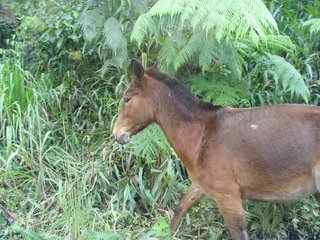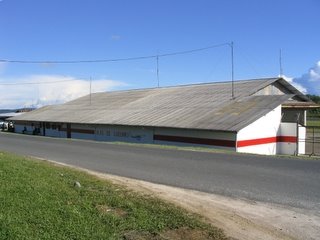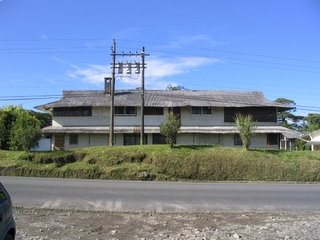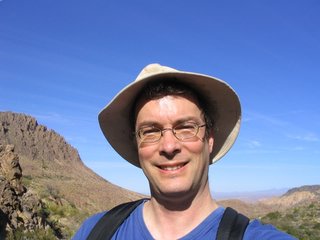August 16, 2006 – Dos Rios to Shell Mera
Tena is at a much lower elevation that we’ve been at, under 2,000 feet, so it’s a bit warmer and a good bit more humid than the rest of our trip so far. So the air-conditioning we have in our rooms at Hotel Los Yutzos is quite welcome. We have a good breakfast at the hotel, including a small plate of fruit, rolls, and scrambled eggs with ham mixed in for each of us. Should keep us well satisfied for our drive south the Puyo and Shell Mera today. Toward the end of breakfast it starts to rain and it’s a real good bit of rain coming down. As we return to our rooms before heading out of town with Walter, we are hoping that the rain doesn’t cause us road problems between Tena and Puyo or when we first track down Dos Rios, where Grandma and Grandpa Cedar had their mission station and Mom grew up her first years. We’re not sure what, if anything, we’ll find, but we’ll give it a try.
We get loaded up in Walter’s car and there’s a good bit of dialogue between Walter and Mom, as Walter thinks Dos Rios is south, on the way to Puyo, while we’re all pretty sure it’s north, based upon maps, Mom’s memories, etc. we’ve consulted. Walter’s great in many ways, but if he gets his mind set in a certain direction, it takes a good bit of effort to steer him elsewhere. But Mom prevails and we go just to the north edge of Tena, where we find a bridge crossing the river as we thought there should be. We cross over and drive a little bit, including passing an evangelical church, and we see a sign for Reuben Larsen barrio. Reuben Larson was the missionary in this location before my grandparents, so that’s a good sign.

The Ruben Larson sign
We then stop and Mom starts talking to a man at a nearby house. His name is Jose Castillo and it turns out he put the sign up as a way to remember Reuben Larson and the mission work that was done here. Mom and he are quickly into much conversation and then John and I and Walter come into the house and sit down. Jose comes into the room and presents us with two wood spears, a short one and a long one, as gifts. We accept them, knowing we can’t take them through customs when we leave the country, but we will give them to Walter to have. Jose is a doctor and he shows us a number of plants he’s growing that have various beneficial health and medical effects. He tells Mom that the church we passed by near his house is an Alliance church and also tells us that just down the hill, on the upper side of the road, the house and barn where Mom lived her first years and Grandpa and Grandma Cedar lived are still standing. Jose tells Mom that if she will come back again, he’ll heal her arthritis in her knees. We very much enjoy Jose’s hospitality and eventually it’s time for us to leave.

Jose, Mom (with spear), and Walter

Walter, Jose, and Mom in an animated conversation
We bid Jose goodbye and then go just down the road to see the house and barn where Mom grew up her first years. The house doesn’t look to have been used for many years, with just the framing in the walls intact. Mom also says that the kitchen, which was added on to the back of the house, isn’t there anymore. The barn has actual siding and looks to be in use, as there’s a couple pieces of clothing hanging out a window and a dog barking, so we don’t go up close to look. Still very exciting though to see the original structures, which Mom says were already there in 1937 when they came. The rain has now subsided, which is nice for taking pictures and also probably a good sign for our trip to Puyo.

Grandpa and Grandma Cedar's mission home, where Mom spent her first years

Grandpa and Grandma Cedar's barn, where they kept animals, etc.

The Christian and Missionary Alliance church just down the hill from Granpa and Grandma Cedar's old home
Time to exit Tena and get to Puyo and then Shell Mera. John had e-mailed several folks at Shell Mera about our schedule being bumped a day, but hadn’t heard back, so we’re not totally sure of where we’re staying tonight. The big question is whether the road to Puyo will be paved and nice, or will it be in bad shape like much of what we had to drive over yesterday on our way to Tena. So far so good, as the first 20-25 miles from Tena are paved and in good condition. But then suddenly the paved road ends, and we’re back to bouncing around a rocky road that at one point today made me think we were driving down a riverbed, rather than a road. The only good thing is we know that we won’t have to go as far today on bad roads as we ended up doing yesterday. However, at one point we were going through some mud and the car stopped. Uh oh! Walter started the car back up and, thanks to the front wheel drive, the car crawled out of the mud and kept going. Then, just moments later, the red battery warning light comes on in the car, so we stop and pop the hood. Now we’re about halfway from Tena to Pujo, really in the middle of nowhere, so any kind of substantive car trouble could make things real interesting. Well, we check the battery, which looks fine, make sure all the fuses are in place, and give it a general look over. But we really don’t see anything that would have cause the red light to come on! Well, we get back in the car and Walter turns it on, and in a few seconds the red light disappears and doesn’t reappear for the rest of the day. I’m not sure what went on with the red light, but Mom says she was praying, which has been know to help in all sorts of situations.

Ecuadorean roadside mud

A roadside spectator
So we continue on and finally escape the rugged road just as we enter Puyo. We then gas up the car and stop for a snack of fish soup to give both us and the car a rest. We’re back on decent paved roads. We head to Shell Mera, just a short distance to the west of Puyo, where we hope to stay at the guesthouse at the HCJB facilities there. We first find the HCJB hospital in Shell Mera, where a nurse helps guide us to the main HCJB facility in Shell Mera. It’s not easy to notice at first, as is often the case with Protestant facilities in Ecuador. This is due to Ecuador still being primarily a Catholic nation, and Protestant groups tend to keep a low profile, to try to avoid unnecessary trouble with the Catholic majority, who still at times not real tolerant of non-Catholic groups. But we get to the HCJB facility and meet Glenda, a lady who with her husband used to run the facility but now are retired and just filling in while the current administrators are on furlough. It turns out they do have room for us (as well as Walter) to stay tonight in the guesthouse. The guesthouse is the original hospital at Shell Mera, and will be torn down soon, as a new one is being built, so we’re staying in a building with a good deal of history within its walls.

The HCJB guesthouse in Shell Mera, where we're staying tonight

The original plaque, dedicating the hospital in 1958
We get settled in a little bit and then Glenda lets us know that the facilities of Mission Aviation Fellowship (MAF) are nearby, where Nate Saint flew from before his death in the famous outreach efforts to the Waodanis and which continues to serve various mission needs in the area. So we decide to go have a look, and we see the current hangar where the mission flies out of (though nobody is around right now), as well as the Nate Saint school for missionary children and the two old homes where the Saints and others lived and continue to live as they serve with MAF. Pretty interesting. We then head for an early dinner at a restaurant Glenda suggested that was owned by a Christian Quichua family, where we have a good meal.

The current Mission Aviation Felloship hangar

Nate Saint's house in Shell Mera
We then head back to the guesthouse, where Walter starts washing his car and John and I decide to take a walk. We pass by Walter and he’s talking to someone, who he introduces to us as Javier. It turns out Walter knew Javier through Walter’s sister working in the HCJB hospital in Quito. We chat for a few minutes and John asks Javier about Nate Saint and the buildings we saw earlier. Javier offers to walk over there with us, as he lives in an apartment at one of the buildings. We walk over there and while we’re walking, Javier asks us if we’d like to meet Marj Saint. Well, at least that’s what we thought he said. It turns out to be Margie Grant, principal at the Nate Saint school. She is tied up until after 8:00 p.m., but says she’d be glad to come visit and talk to us and hear about Mom’s Ecuador experiences. So she came over to the guesthouse a little bit after 8:00 p.m. and Mom shows here a number of pictures and things and gives her a copy of Mom’s recently completed story of Grandpa and Grandma Cedar’s missionary times in Ecuador. Margie is very interested and spends a little over two hours with us, hearing about Mom’s Ecuador experiences and sharing a little bit with us about what she does and some of the challenges facing MAF these days. An enjoyable time is had by all. So time to hit the sack and get some rest for a full day tomorrow as we head back to Quito. Hopefully we’ll get some clear weather so we can take advantage of our last opportunity to see Tungurahua and Chimborazo.
We get loaded up in Walter’s car and there’s a good bit of dialogue between Walter and Mom, as Walter thinks Dos Rios is south, on the way to Puyo, while we’re all pretty sure it’s north, based upon maps, Mom’s memories, etc. we’ve consulted. Walter’s great in many ways, but if he gets his mind set in a certain direction, it takes a good bit of effort to steer him elsewhere. But Mom prevails and we go just to the north edge of Tena, where we find a bridge crossing the river as we thought there should be. We cross over and drive a little bit, including passing an evangelical church, and we see a sign for Reuben Larsen barrio. Reuben Larson was the missionary in this location before my grandparents, so that’s a good sign.

The Ruben Larson sign
We then stop and Mom starts talking to a man at a nearby house. His name is Jose Castillo and it turns out he put the sign up as a way to remember Reuben Larson and the mission work that was done here. Mom and he are quickly into much conversation and then John and I and Walter come into the house and sit down. Jose comes into the room and presents us with two wood spears, a short one and a long one, as gifts. We accept them, knowing we can’t take them through customs when we leave the country, but we will give them to Walter to have. Jose is a doctor and he shows us a number of plants he’s growing that have various beneficial health and medical effects. He tells Mom that the church we passed by near his house is an Alliance church and also tells us that just down the hill, on the upper side of the road, the house and barn where Mom lived her first years and Grandpa and Grandma Cedar lived are still standing. Jose tells Mom that if she will come back again, he’ll heal her arthritis in her knees. We very much enjoy Jose’s hospitality and eventually it’s time for us to leave.

Jose, Mom (with spear), and Walter

Walter, Jose, and Mom in an animated conversation
We bid Jose goodbye and then go just down the road to see the house and barn where Mom grew up her first years. The house doesn’t look to have been used for many years, with just the framing in the walls intact. Mom also says that the kitchen, which was added on to the back of the house, isn’t there anymore. The barn has actual siding and looks to be in use, as there’s a couple pieces of clothing hanging out a window and a dog barking, so we don’t go up close to look. Still very exciting though to see the original structures, which Mom says were already there in 1937 when they came. The rain has now subsided, which is nice for taking pictures and also probably a good sign for our trip to Puyo.

Grandpa and Grandma Cedar's mission home, where Mom spent her first years

Grandpa and Grandma Cedar's barn, where they kept animals, etc.

The Christian and Missionary Alliance church just down the hill from Granpa and Grandma Cedar's old home
Time to exit Tena and get to Puyo and then Shell Mera. John had e-mailed several folks at Shell Mera about our schedule being bumped a day, but hadn’t heard back, so we’re not totally sure of where we’re staying tonight. The big question is whether the road to Puyo will be paved and nice, or will it be in bad shape like much of what we had to drive over yesterday on our way to Tena. So far so good, as the first 20-25 miles from Tena are paved and in good condition. But then suddenly the paved road ends, and we’re back to bouncing around a rocky road that at one point today made me think we were driving down a riverbed, rather than a road. The only good thing is we know that we won’t have to go as far today on bad roads as we ended up doing yesterday. However, at one point we were going through some mud and the car stopped. Uh oh! Walter started the car back up and, thanks to the front wheel drive, the car crawled out of the mud and kept going. Then, just moments later, the red battery warning light comes on in the car, so we stop and pop the hood. Now we’re about halfway from Tena to Pujo, really in the middle of nowhere, so any kind of substantive car trouble could make things real interesting. Well, we check the battery, which looks fine, make sure all the fuses are in place, and give it a general look over. But we really don’t see anything that would have cause the red light to come on! Well, we get back in the car and Walter turns it on, and in a few seconds the red light disappears and doesn’t reappear for the rest of the day. I’m not sure what went on with the red light, but Mom says she was praying, which has been know to help in all sorts of situations.

Ecuadorean roadside mud

A roadside spectator
So we continue on and finally escape the rugged road just as we enter Puyo. We then gas up the car and stop for a snack of fish soup to give both us and the car a rest. We’re back on decent paved roads. We head to Shell Mera, just a short distance to the west of Puyo, where we hope to stay at the guesthouse at the HCJB facilities there. We first find the HCJB hospital in Shell Mera, where a nurse helps guide us to the main HCJB facility in Shell Mera. It’s not easy to notice at first, as is often the case with Protestant facilities in Ecuador. This is due to Ecuador still being primarily a Catholic nation, and Protestant groups tend to keep a low profile, to try to avoid unnecessary trouble with the Catholic majority, who still at times not real tolerant of non-Catholic groups. But we get to the HCJB facility and meet Glenda, a lady who with her husband used to run the facility but now are retired and just filling in while the current administrators are on furlough. It turns out they do have room for us (as well as Walter) to stay tonight in the guesthouse. The guesthouse is the original hospital at Shell Mera, and will be torn down soon, as a new one is being built, so we’re staying in a building with a good deal of history within its walls.

The HCJB guesthouse in Shell Mera, where we're staying tonight

The original plaque, dedicating the hospital in 1958
We get settled in a little bit and then Glenda lets us know that the facilities of Mission Aviation Fellowship (MAF) are nearby, where Nate Saint flew from before his death in the famous outreach efforts to the Waodanis and which continues to serve various mission needs in the area. So we decide to go have a look, and we see the current hangar where the mission flies out of (though nobody is around right now), as well as the Nate Saint school for missionary children and the two old homes where the Saints and others lived and continue to live as they serve with MAF. Pretty interesting. We then head for an early dinner at a restaurant Glenda suggested that was owned by a Christian Quichua family, where we have a good meal.

The current Mission Aviation Felloship hangar

Nate Saint's house in Shell Mera
We then head back to the guesthouse, where Walter starts washing his car and John and I decide to take a walk. We pass by Walter and he’s talking to someone, who he introduces to us as Javier. It turns out Walter knew Javier through Walter’s sister working in the HCJB hospital in Quito. We chat for a few minutes and John asks Javier about Nate Saint and the buildings we saw earlier. Javier offers to walk over there with us, as he lives in an apartment at one of the buildings. We walk over there and while we’re walking, Javier asks us if we’d like to meet Marj Saint. Well, at least that’s what we thought he said. It turns out to be Margie Grant, principal at the Nate Saint school. She is tied up until after 8:00 p.m., but says she’d be glad to come visit and talk to us and hear about Mom’s Ecuador experiences. So she came over to the guesthouse a little bit after 8:00 p.m. and Mom shows here a number of pictures and things and gives her a copy of Mom’s recently completed story of Grandpa and Grandma Cedar’s missionary times in Ecuador. Margie is very interested and spends a little over two hours with us, hearing about Mom’s Ecuador experiences and sharing a little bit with us about what she does and some of the challenges facing MAF these days. An enjoyable time is had by all. So time to hit the sack and get some rest for a full day tomorrow as we head back to Quito. Hopefully we’ll get some clear weather so we can take advantage of our last opportunity to see Tungurahua and Chimborazo.


3 Comments:
This comment has been removed by a blog administrator.
Excellent report! BTW if you hadn't had time to check the Gray Gunners won their cup match 3-0...
what a day!
Post a Comment
<< Home